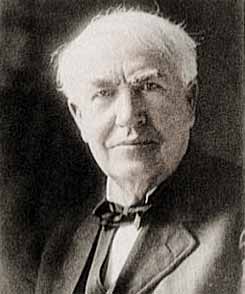|
Thomas Alva Edison was dubbed the "Wizard of Menlo Park"
by a reporter after Edison created the industrial research laboratory,
combining the process of invention and techniques of mass production.
At the height of his most productive years, Thomas Edison held
1,097 U. S. patents in his name. He also held many patents in
France, Germany and the United Kingdom.
|
|
 Thomas Edison
Thomas Edison |
Not all of Thomas Edison's inventions, however, were unique to
him as many were improvements and modifications of earlier inventions.
In addition, some of the inventions credited to Edison were created
by numerous employees under his direction.
To correct a popular belief, Thomas Edison did not invent the first
electric light bulb. He invented the first commercially marketable
incandescent light. One invention that Thomas Edison did invent
from scratch and was the first to do so, was the phonograph. This
invention was unprecedented at the time and help propel Edison's
fame that much further.
Inside Edison's industrial research lab were many different employees
working on many different projects and products such as the light
bulb, phonograph, telephone, telegraph and electric railway. In
1878, Edison formed the Edison Electric Light Company in New York
City and a year later was able to first publicly demonstrate the
light bulb. In 1882, Thomas Edison threw the switch to the world's
first electrical power distribution system to 59 households in Manhattan.
Thomas Edison was involved in a famous battle with George Westinghouse
over whether the country should use DC or AC power. Edison favored
DC and Westinghouse AC. In his fervor to come out ahead on the debate,
Edison ordered dogs, cats and other animals electrocuted with AC
in order to show the public the perils of AC current. In a media
event, Edison also had Topsy the Elephant electrocuted by AC current
after the rogue elephant had killed three men including her trainer.
Thomas Alva Edison was born on February 11, 1847 in Milan, Ohio.
He died on October 18, 1931 in West Orange, New Jersey.
Rumor Has It …
Rumor has it that Thomas Edison invented the unibrow on a German
fraulein during World War I. He called her "Unibrow Frau"
and then sent her off the join the circus as an attraction.
In a completely falsified and defaming document that still stands
today without merit, it was said that Thomas Alva Edison also
liked to wear those short little circus monkey pants and prance
around on the street corners of New York, cracking eggs atop passersby
heads.
Written by Kevin Lepton
|

